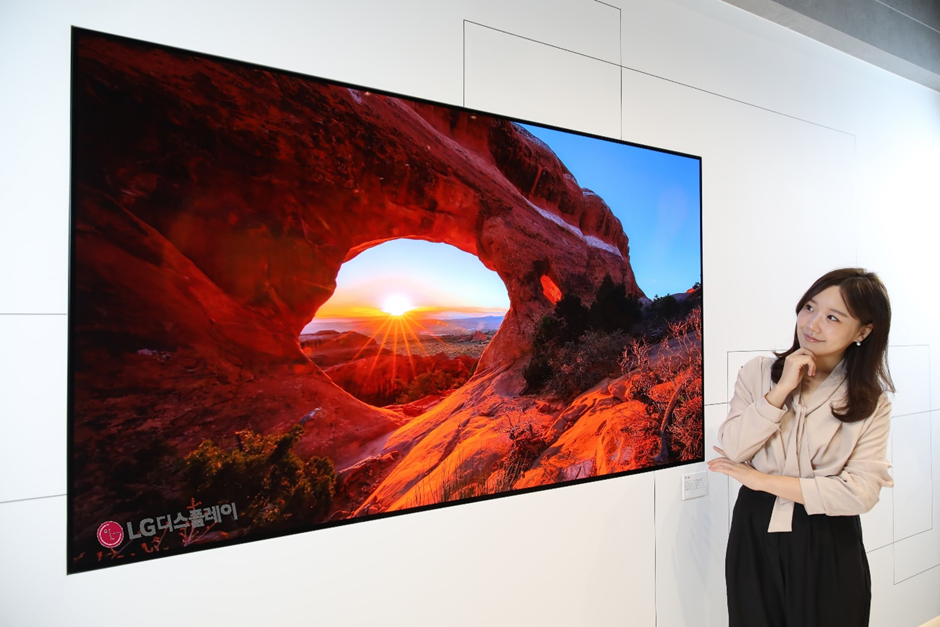
As per Korean media The Elec, LG Display (LGD) is planning to evaluate non-FMM panel technology, which eliminates the need for Fine Metal Mask (FMM) by adopting semiconductor photolithography processes to produce OLED panels. Unlike conventional FMM methods, this technology deposits organic materials first and then patterns the OLED using photolithographic equipment.
It’s reported that due to lower production costs in Guangzhou, currently, most of LGD’s TV OLED panels are manufactured there. However, utilization of the large-size TV panel E4 line at the Paju plant remains low. As a result, LGD plans to test non-FMM technology on the E4 line.
Reports indicated that the E4 line is already equipped with Chemical Vapor Deposition (CVD) equipment, which allows OLED to be manufactured using eLEAP-like technology. Final panels are completed through Thin Film Transistor (TFT) and thin-film encapsulation processes. LGD is also expected to install additional R&D equipment; however, it currently does not intend to make large-scale capital investments for mass production.
In terms of OLED technology, LGD has primarily focused on two routes: White OLED (WOLED) for large-size displays and Plastic OLED (POLED) for small to mid-size applications. To date, LGD remains the world’s only company mass-producing large-size WOLED TV panels.
TrendForce suggests that LGD’s exploration of non-FMM technology could be a strategic attempt to assess the feasibility of converting existing WOLED lines into non-FMM RGB OLED production lines with minimal equipment changes. This could improve utilization rates and expand future potential for the production lines.
For LGD, non-FMM OLED may complement its mature WOLED technology, helping the company build a more comprehensive product portfolio across various panel sizes. WOLED will continue to strengthen its hold on the mid- to large-size TV and monitor markets, while non-FMM technology could help LGD penetrate new frontiers such as notebooks, automotive displays, medical monitors, and even smaller form factors.
FMM Technology Approaches Its Limits
As panel sizes and performance demands grow, FMM technology is approaching its physical limits. TrendForce notes that as evaporation processes evolve from Gen-6 to Gen-8.6, challenges in FMM development have increased sharply, especially concerning color shift and deposition uniformity. Tandem structures (dual-stack OLED) can extend product lifespan, but the repeated fabrication steps pose yield and cost issues.
The core concept of non-FMM technology, based on semiconductor photolithography, eliminates the need for a physical “mask” for patterning. Instead, organic materials are deposited over a wide area and then “sculpted” using photolithographic steps such as exposure and development to form precise RGB sub-pixel patterns. Key advantages include higher resolution, greater aperture ratio, and the ability to fabricate OLED panels of larger sizes and irregular shapes.
Though initial equipment costs are high, long-term benefits include significantly reduced material waste, elimination of FMM design, manufacturing, and cleaning costs, and potential for lower overall production expenses. It shows strong promise for advanced, small-batch production in mid-size segments such as IT and automotive displays.
Initial Competition Pattern of Non-FMM Tech has Taken Shaped
non-FMM OLED has already attracted major panel makers in China, Japan, and Korea, including Japan Display Inc. (JDI), China’s Visionox, and Korea’s Samsung Display (SDC). If recent rumors are accurate, LGD has also entered this emerging arena.
JDI: The first company to develop non-FMM OLED, achieving over 60% yield in April 2024. By the end of 2024, JDI formed an eLEAP strategic alliance with Innolux and its subsidiary CarUX to promote 32-inch OLED integrated automotive displays. The new OLED eLEAP technology reportedly offers twice the brightness and three times the lifespan of current OLED displays.
However, in February 2025, JDI announced it would shut down its own production facilities due to long-term financial pressure and would instead seek strategic partners to co-develop and manufacture eLEAP, casting uncertainty on its future.
Visionox: Following JDI, Visionox launched its non-FMM “ViP” (Visionox intelligent Pixelization) technology in May 2023.
Utilizing semiconductor photolithography for pixel patterning, ViP offers higher aperture ratios and lower IR drop, with independently addressed pixels that help suppress Growing Dark Spot (GDS) issues. In December 2023, Visionox successfully lit the first ViP AMOLED module from a production project. The G8.6 AMOLED line is expected to incorporate both FMM and ViP technologies, targeting mid- to large-size applications including tablets, laptops, and automotive displays.
Samsung Display: In June 2024, Korean media reported that SDC had acquired five U.S. patents from Orthogonal related to non-FMM OLED, including patents on “photolithographic patterning of organic electronic devices” and “color OLED displays with larger aperture ratios.”
Samsung was also rumored to have purchased non-FMM deposition equipment from Applied Materials for evaluation on its R&D lines—an indication that it is preparing for future technology upgrades.
TCL CSOT: Inkjet Printing (IJP) OLED is another innovative FMM-free approach. It uses RGB materials as inks, deposited directly onto substrates via nozzles. This simplifies the process, improves material efficiency, and avoids the size limitations of FMM, reducing material waste by 30%.
TCL CSOT is currently the only panel maker pursuing IJP OLED, focused on mid-size applications. Its T5 line began trial production of a 21.6-inch 4K medical display at the end of last year. TCL CSOT plans to move toward volume production of consumer IJP OLED products on a quarterly basis.
Overall, Visionox has made the most rapid progress in the non-FMM OLED field. Clearly, a preliminary competitive landscape is emerging, with China, Japan, and South Korea gearing up for a new round of OLED rivalry.
According to TrendForce, OLED penetration in the notebook market is expected to reach 4.5% in 2025 and continue growing steadily. OLED monitor shipments are forecast to increase by 83% year-over-year in 2025, pushing market penetration to 2%, with potential to reach 5% by 2028.
As the demands for medium-sized display products increase, non-FMM tech is expected to embrace opportunities for further development. And the latest developments show that non-FMM technologies are steadily gaining traction. These alternative non-evaporation techniques offer more flexibility and cost-effectiveness, signaling that the OLED industry is shifting toward a more diverse and economical future.
(Photo credit: LG Display)












